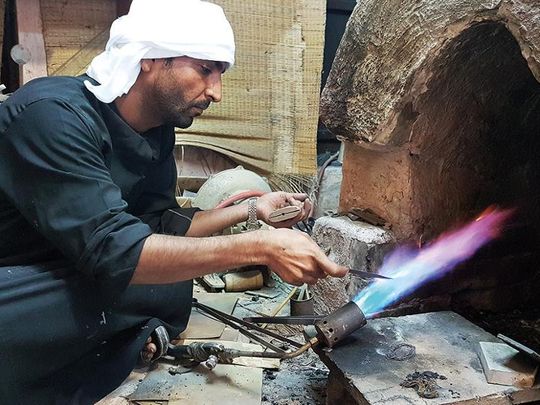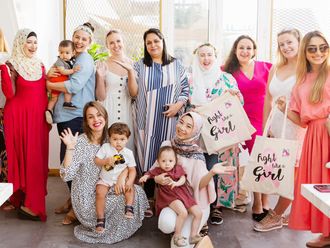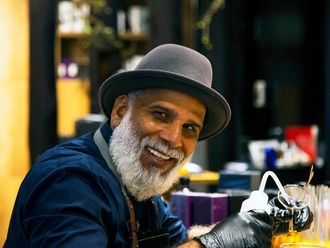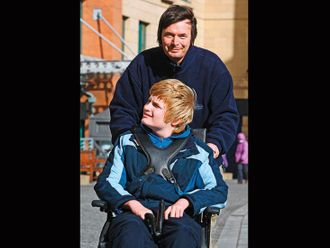
Abdulrahman Abood Ahmad bin Nahaira may well be Abu Dhabi’s last khanjar maker. In his small workshop in the capital’s Emirates Heritage Club, he mostly makes the once famous Emirati dagger – locally known as khanjar – for tourists looking for souvenirs, but every once in a while there is a large order from a VIP or even a private order for a ‘special’ dagger.
‘I am the one who makes all the Emirati daggers given as gifts to competition winners at heritage festivals in Abu Dhabi emirate,’ he says.
‘It is not a lost tradition, but people nowadays don’t wear it as they used to in the old days. Only at some special occasions, certain ceremonies or maybe weddings, Emirati men may wear a khanjar. It is still very popular, though, in Oman and Yemen.’
Abdulrahman learnt the skill of making daggers and swords from his father, in his Yemeni homeland, a skill that, in fact, was passed down from generation to generation in his family.
Some 14 years ago, Emirates Heritage Club offered him a job as a khanjar craftsman. He has been in Abu Dhabi ever since, one of the very few professional dagger makers in the emirate.
‘Since I was a kid I used to watch my father making daggers and then, when I was about 18 years old, I started making my own,’ remembers Abdulrahman.

‘See, this is my father, here’, he goes on, pointing to an old Gulf News calendar picture.
‘We both came here, in 2003, working for the Emirates Heritage Club, but eventually, my father returned to Yemen.’
Nowadays, Abdulrahman makes daggers using iron cut from old car springs, which he heats in a fire, hammering and polishing for two days, until he achieves the right size and blade shape. The next step is to fit the blade with a handle of wood. Then he has to cover the cutting edges of the blade with slabs of wood cut to fit the curvature of the blade, but continuing to curve past the end point. This is done for artistic purposes and also to give the illusion that the blade, once it’s inside the scabbard, won’t be able to come out again.
Finally, he covers the wooden holder with cloth or decorates it with sheets of aluminium, brass or silver. All in all, it takes him six days to complete a khanjar, but in the old days, the process would take weeks, even three to four months for just one dagger.
‘These are all aluminium and copper foil coated daggers. In the past, the most expensive dagger used to be the silver one, sometimes mixed with gold, with elephant or rhino ivory handles. Occasionally, I receive requests from people to make one. Of course, we no longer use ivory, replacing it with silver or other materials. The old style, traditional silver daggers cost about Dh3,000, but the aluminium souvenir ones are between Dh150 and Dh300, depending on size’.
The curved, ‘J’ letter shaped dagger is believed to have its origins in Oman. Robert Padbrugge, who visited Muscat in 1672 as a representative of the Dutch East Indies Company, mentioned in his journal the rock carvings discovered on a gravestone in Ruus Al Jibal – now known as Musandam – believed to pre-date the Wahhabi revival in the 1700s. These carvings are thought to be the first historical evidence of the Arabian khanjar, which varies slightly in shape and design from region to region.
In the 18th century, the khanjar became a symbol on the royal crest of Al Said, Oman’s ruling family. More precisely, Oxford professor Dawn Chatty pointed out in a study that the Omani emblem of crossed khanjars may have dated back to the reign of Taymur bin Feisal (Sultan of Muscat and Oman from 1913 to 1932), if not Feisal bin Turki (Sultan of Muscat and Oman from 1888 to 1913). Subsequently, the khanjar has become the national emblem of Oman.
Still, even there, the khanjar is worn mostly during official ceremonies, holidays and celebrations.
Swords and daggers are no longer in use as military weapons in the region, but in the Arab world they are still popular as ceremonial ornaments, especially the famous curved Arab dagger. The deadly khanjar, in fact, with its layers of silver and gold and its gem-studded scabbard, is often the most striking part of a man’s attire at formal dinners, weddings or important civic or military events.
Due to the limited lifespan of the different dagger parts, it is very rare to find a khanjar older than 200 years. One of the oldest known daggers that still exist today was bought in Sanaa in 1763 by the Danish traveller Carsten Niebuh.
Yemen, particularly in the north, is the last place where the khanjar is still very much part of the daily attire, just as rifles are always carried by tribesmen in the south.
Noman Saleh, who used to run his own travel agency in Yemen before the war and now works in the tourism industry in Abu Dhabi, says there is nothing alarming about that.
‘Men wear the khanjar daily. They are not looking to fight; it is not a threat. It’s just a symbol of masculinity,’ he reassures.

Walking through Sanaa’s never-ending souk, there are entire areas reserved for only selling khanjar belts or dedicated to metal workshops, where metal artisans are crafting beautiful daggers. To this day, it is still customary at Yemeni weddings for men to dance holding up their daggers. They also use these weapons for daily chores, when cutting through bushes to reach remote sidr honey hives, for example, or when going hunting.
‘Yemeni khanjars are quite different from Emirati and Omani ones. They are bigger and more decorative. Some even come in a ‘U’ shape, although that’s just the cover, the actual blade being the same, usual size,’ explains Zowaina Al Mameri, in charge of collections at Al Ain National Museum.
In its weapon section, the museum displays 12 old Arab daggers of different sizes and styles from the UAE, Oman and Yemen. Their actual age is not known, but they were brought here in the early 1970s.
‘About that time, in the 70s, people here, in the emirates, stopped wearing the khanjar. Most still have them, but they are very rarely worn, either at some heritage related events or during the National Day,’ points out Zowaina.

‘In the old days, most Emirati daggers were made in Sharjah or Oman. If you look at pictures of the late Shaikh Zayed Bin Sultan Al Nahyan, he wears a Saheli khanjar. The Saheli, which comes from Sharjah, is the famous Emirati dagger design. It is smaller than the others’.
Khanjars are also worn in Bahrain and Saudi Arabia, but most specifically during special occasions. Apart from subtle design pattern differences, the Abu Dhabi khanjar is very similar to the Omani ones, which vary in style from region to region. The rarest, Al Saidi Khanjar, which takes its name from the royal Omani family, is mostly worn by Al Busaidi tribe in Oman. It is distinguished with its geometrical designs that have traces of floral patterns.
Al Dahra Khanjar is famous for its horn hilt and detailed silver wirework.
The grip of Al Sharqiyah Khanjar takes the shape of a horn and has a collar made of decorated gold. Its sheath is decorated in gold and silver and has unique silver and gold ribbon wireworks.
Al Batinah Khanjar has a horn grip, which is covered with silver collar and silver ribbon work.
The Dhofar Khanjar can only be found in the Dhofar region in southern Oman, and it is influenced by the Yemeni dagger, which is called Jambiyah.
The people of Yemen have two secondary names for the jambiyah: asib and tuza. The first refers to the type worn by tribesmen and ordinary people in the towns, while the second is applied to those worn by the aristocrats or chieftains. In both cases the blades are usually exactly the same, but the two types have different kinds of sheaths, and each is worn in a distinctive way. Asib has a cloth cover and is normally larger and worn in front of the belt, while tuza is worn sideways and has a more decorative sheath, often covered in silver.

The coastal dagger of the present-day UAE, known as Khanjar Saheli, is made of silver and is highly decorated. Quite often, the bishak (knife) was worn instead of the dagger, particularly in the eastern area of the UAE. The carved wooden scabbard is further embellished with silver on both the wooden hilt and the iron blade.
‘The khanjar is worn in many parts of the Arabian Peninsula, but it is particularly popular in UAE and Oman, and the south-west, which is Yemen. They were once a defensive weapon, and also used in hunting, but, of course, they are now decorative, a symbol of old traditions,’ adds Zowaina.
She says there is currently very little published research about the Arabian dagger and a lot more research is needed to better understand the history and traditions surrounding it and to preserve it as a distinguished Arab heritage.
In the UAE, the Cultural Programmes and Heritage Festivals Committee – Abu Dhabi wants to change all that and revive the Emirati dagger as part of UAE’s heritage. This year, the Committee is launching a new initiative focused on the khanjar, presenting it at all its annual festivals throughout the year.

The Emirati dagger initiative is meant to preserve the craftsmanship of making traditional daggers, create a market to sustain this craft, promote the culture of carrying daggers, conserve old, traditional daggers in the UAE and document the traditional dagger craft.
The making of traditional daggers is a craft that requires specialised knowledge and great skills in working with materials such as ivory, leather and wood. In addition, the craftsmen are required to master the art of silver filigree, using various techniques – casting, moulding, adornment, stamping, engraving, granulation, gilding and polishing among them. The finest quality daggers always stand apart, being the most expensive on the market, and showing the higher status of their holders.
To make a khanjar, the curved blade should be attached to an adorned handle. The dagger has four different parts, each one made separately before assembly.
The handle is made of wood, ivory, metal or resin.
The blade is bent and sharpened from both sides until reaching the tip. In the past, blades were more valuable than handles, some being passed from father to son. It was also customary for some families to keep the finest blades.
The dagger is always worn tucked under a belt, which is adorned with embroidery or a cloth made of silk or cotton. Rings mounted on the right curve of the sheath are used to attach the dagger to the belt. A small leather purse is also tied to the belt, mostly for carrying money or other valuables. Some belts had a bandolier too for holding ammunition and cartridges.
Also read: Meet Ramesh Shukla, the man who captured the Spirit of the Union photograph
The inner part of the sheath is made of wood, preferably teak. The sheath is then covered with a layer of silver or leather decorated with fine silver engravings. The tip of the sheath is covered with a silver leaf – the chape - and it can be either simple or engraved. The chape protects and strengthens the sheath.
In time, carrying a dagger was not only a self-protection necessity, but it became a symbol associated with noble values, notably strength, dignity, courage, honour, nobility and pride.











